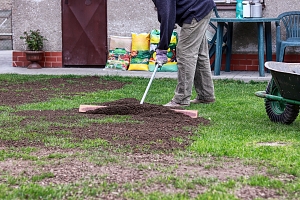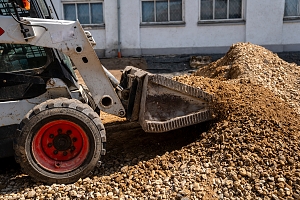From the relentless onslaught of melting snow to the seasonal downpours of rain, the perpetual challenge your home faces is the management of water and moisture. It’s imperative to ensure that your property is correctly graded, steering water away from your home and preventing it from infiltrating the ground. Timely evaluation and correction of your yard’s grading can thwart potential long-term damage, even if the signs are not immediately evident.
The Significance of Proper Yard Grading
 Water accumulation, while benign in expansive natural landscapes, can wreak havoc on residential or commercial properties. Rain and melting snow contribute to a natural process where water is absorbed into the ground. While beneficial for unregulated land, this process can spell disaster for your home. Infiltrating your property’s soil, water has the potential to shift the ground, compromise your foundation, and infiltrate piping.
Water accumulation, while benign in expansive natural landscapes, can wreak havoc on residential or commercial properties. Rain and melting snow contribute to a natural process where water is absorbed into the ground. While beneficial for unregulated land, this process can spell disaster for your home. Infiltrating your property’s soil, water has the potential to shift the ground, compromise your foundation, and infiltrate piping.
The consequences are dire—irreversible structural damage, shifting walls, uneven floors, and the looming risk of a compromised roof—all attributed to water. Prevention becomes the linchpin for preserving your home’s foundation and ensuring its structural integrity stands the test of time.
Understanding the Mechanism of Grading
Grading is a strategic technique employed to establish a gentle slope leading away from your home, guiding water to move in tandem with it. While minimal water seepage remains inevitable, it remains within the limits beneficial for vegetation.
Typically conducted during site preparation before and after construction, grading is a fundamental measure to safeguard your property. However, erosion over time, especially for homes with several decades under their belt, necessitates periodic checks to ensure the continued efficacy of grading.
The Collaboration of Grading and Drainage
In the intricate dance of water management around your property, the collaboration between grading and drainage systems creates a harmonious symphony of protection. While drainage systems are specifically crafted to redirect water, their effectiveness is significantly enhanced when working in tandem with the strategic grading of the landscape. This synergistic relationship serves as a robust defense mechanism against potential water-related issues, showcasing the importance of these two components in unison.
Guiding Water Away
Grading, with its artful creation of a gentle slope away from your home, acts as the initial line of defense. Its primary objective is to guide water away from your foundation, ensuring that the gravitational force naturally propels water towards designated paths. This proactive approach mitigates the risk of water infiltrating the soil around your home, averting the potential pitfalls of ground shifting and foundation compromise.
Channeling Toward Drainage Areas
However, the collaboration goes beyond mere diversion; it involves purposeful guidance. Grading doesn’t just deter water from your foundation; it intricately channels it towards predetermined drainage areas. In a meticulously orchestrated sequence, the graded landscape seamlessly integrates with drainage systems, ensuring that water is directed to specific zones designed to handle its flow efficiently.
Elaborate Drainage Systems
In properties of greater scale and complexity, where the terrain demands a more intricate solution, elaborate drainage systems come into play. These systems, often featuring ingeniously designed man-made ditches, are strategically engineered to channel water away from targeted zones. These zones may include delicate landscaping, low-lying areas prone to flooding, or regions where water accumulation poses a threat. The marriage of grading and these advanced drainage solutions transforms potential water hazards into a well-managed, controlled flow.
Preventing Erosion and Damage
Beyond the foundation-centric aspects, the collaboration between grading and drainage is also instrumental in preventing erosion. The strategic flow of water, guided by both the natural slope and man-made drainage features, reduces the risk of soil erosion. This proactive measure safeguards not only your foundation but the entire landscape, preventing soil displacement and preserving the integrity of your property.
Regular Maintenance and Checks
Given the dynamic nature of the elements, regular maintenance and checks become crucial. Erosion, weathering, or unforeseen changes in the landscape can impact the effectiveness of both grading and drainage systems over time. Periodic assessments ensure that these vital components continue to work seamlessly together, providing your property with the robust water management it requires.
The collaboration of grading and drainage transcends the rudimentary task of water redirection. It is a meticulous orchestration, a partnership that safeguards your home from the potential perils of water infiltration. Together, they create a fortified defense, ensuring that water flows purposefully away from critical areas, preserving the structural integrity and longevity of your property.
DIY Grading Assessment
 For homeowners keen on maintaining the longevity and structural integrity of their properties, a do-it-yourself grading assessment stands as an accessible yet powerful tool. Contrary to misconceptions, this evaluation doesn’t necessitate advanced tools or specialized expertise. Rather, a straightforward observational approach empowers you to gauge the efficacy of your yard’s grading. Let’s delve into the user-friendly steps that demystify this process:
For homeowners keen on maintaining the longevity and structural integrity of their properties, a do-it-yourself grading assessment stands as an accessible yet powerful tool. Contrary to misconceptions, this evaluation doesn’t necessitate advanced tools or specialized expertise. Rather, a straightforward observational approach empowers you to gauge the efficacy of your yard’s grading. Let’s delve into the user-friendly steps that demystify this process:
Street-Level Observation
Begin your assessment by stepping out to the street and positioning yourself to view your property from both the front and back. The key here is to observe the natural slope of your yard towards your house. A slight upward slope is a promising indicator, signifying that water is naturally inclined to flow away from your home. This fundamental principle of grading—creating a gentle descent away from your foundation—forms the foundation of effective water management.
Wall Proximity Inspection
While the overall slope is crucial, attention to detail is equally important. Walk closer to your home and scrutinize the areas adjacent to your exterior walls. These regions are potential trouble spots where water may accumulate. Look for depressions or indentations that could trap water, compromising the effectiveness of the grading. If these areas appear concave or sunken, they may need attention to ensure proper water runoff and prevent potential water seepage into your foundation.
Post-Rain Evaluations
Nature’s test provides valuable insights. After a rainfall, take a stroll around your property to observe how water behaves. Note any pooling or accumulation in specific areas, especially near your home. The presence of standing water is a red flag, indicating potential grading issues. Keep an eye out for patterns and areas where water tends to linger, as these could be indicative of inadequate drainage or grading concerns.
Gutter Monitoring
A crucial aspect of grading efficacy is its synergy with gutter systems. Check your gutters during and after rain events to ensure they are effectively directing water away from your home. Overflowing or clogged gutters can compromise the grading by allowing water to spill near your foundation. Regular gutter maintenance is a proactive step in preserving the collaborative effort between grading and drainage.
Utilize Rain as a Tool
Embrace rain as a diagnostic tool for your grading assessment. Observe how water behaves, where it flows, and whether it follows the desired path away from your home. If you notice deviations or areas of concern, it’s an indication that adjustments may be needed.
A DIY grading assessment transforms the seemingly complex task of water management into an accessible endeavor for homeowners. By integrating keen observations with the natural cues provided by rain, you become an active participant in preserving the health and resilience of your home. Remember, a proactive approach to grading maintenance is a small investment with substantial returns in safeguarding your property against potential water-related challenges.
Reach Out to Northern Virginia’s Yard Grading Professionals
 If uncertainties persist or corrections are required, engaging professionals becomes paramount. Grading often involves the use of fill dirt to establish a stable and even surface. Companies offering professional fill dirt delivery and grading services, like Dirt Connections, can provide expertise in ensuring your yard grading aligns with best practices.
If uncertainties persist or corrections are required, engaging professionals becomes paramount. Grading often involves the use of fill dirt to establish a stable and even surface. Companies offering professional fill dirt delivery and grading services, like Dirt Connections, can provide expertise in ensuring your yard grading aligns with best practices.
Whether it’s rectifying indentations near walls or delivering fill dirt for comprehensive grading and land projects, seeking professional assistance ensures your property receives the attention it deserves. Don’t hesitate to get in touch with Dirt Connections, we will ensure your Northern Virginia yard grading is done properly.








































